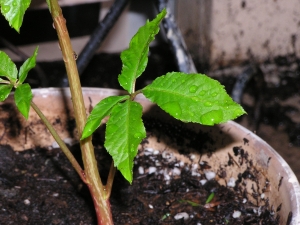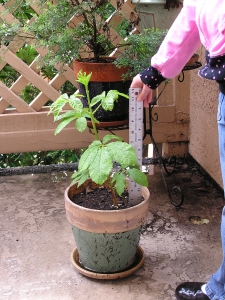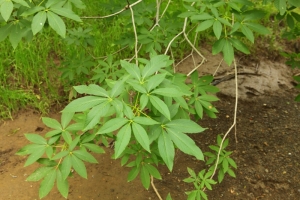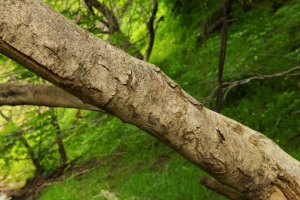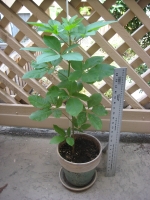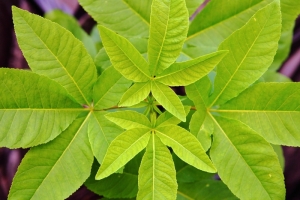Projects
Horse Chestnut Tree?
Sat, Jan 23rd, 2010 - Project Status: Closed

Measuring the Horsechestnut Tree
The next day, after a quick internet search I learned that it is best to plant the seeds sooner than later. With my daughters help (she loves playing in dirt) we planted the seed in a pot and watered it. Unfortunately, I didn't take a picture of the seed before planting it. Today, almost two months from the day we planted the seed, I noticed that it has sprouted. In fact, it is approximately 8 inches tall already, so it must have sprouted days ago.
There is a mystery about the true identity of this tree. My family has always called the trees down by the creek Horsechestnut, but after reading the National Audubon Society tree field guide about Horsechestnut trees and information on the internet I believe this tree and the ones growing on my dad's property are California Buckeye, a close relative. This is because the seedpod which produced the seed I planted was smooth and not spiny like Horsechestnut seedpods are described in everything I have read so far. Another difference between the Horsechestnut tree and the California Buckeye is the bark. The Buckeye has light gray, thin, mostly smooth bark and the Horsechestnut bark is described as gray or brown, thin, smooth becoming fissured and scaly. Armed with this information, I should be able to determine what kind of tree they are the next time I visit them.
Here is the data my daughter and I collected regarding our young tree.
Height: 8 inches
Leaf Color: Green
Trunk Color: Red/Green
Bunches of Leaves: 3
I plan to return to my Dad's place and photograph the trees blooming and also take note of the bark and other tree attributes. I will post information regarding this project as additional data is collected. Check back for updates on the progress of this tree project.
Date: 02/06/2010
Height: 14" approximately
Notes: This tree has grown 5" in two weeks. The palmately compound leaf type with 5 leaflets typical of a California Buckeye is apparent. The Horsechestnut tree has the same leaf type but with 7 leaflets usually.
Date: 04/03/2010
It's been over a month since my last project update. A few things have happened since then. Approximately three weeks ago, this young plant barley escaped major injury or death. During a severe rain storm a strong gust of wind knocked over an adjacent plant stand which came crashing down inches from our plant. One geranium and it's clay pot was broken to pieces but our little tree was fine. Two weeks ago I visited my dad and walked to the creek to study the parent tree. I was hoping to photograph the parent tree blooming but, I have since learned that it's too early in the year for these trees to flower. So I will return in late spring or early summer in hopes of documenting a flowering tree. However, another feature of the parent tree has made it perfectly clear of the species of our young tree - the bark. I have compared the bark of the parent tree to the pictures of Horsechestnut and California Buckeye depicted on page 303 in the National Audubon Society Tree Field Guide. The bark of the parent tree matches the picture of the California Buckeye tree bark. Additionally, the leaves depicted in the same picture match that of the parent tree. Case closed - I can now say I'm growing a California Buckeye tree with confidence. I will still continue to post pictures of my tree and the parent tree but I am changing the status of this project to closed. I do want to note that I am pleased with the symmetry this tree exhibits and hope it continues to grow in such a fashion unlike the parent tree.
Project Images
Measuring the Horsechestnut Tree Leaves of our young tree. Over a foot tall already. 02/06/10 Palmately Compound Leaf Type 5 Leaflets Parent tree leaf group Parent tree leaning over creek Parent tree bark Height on 03/21/2010 Nice Symmetry!
